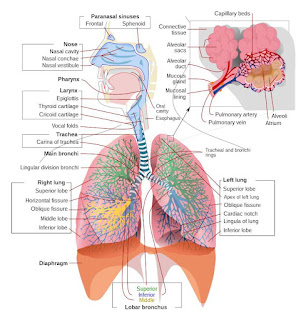The human lungs
Introduction:
The human lungs, magnificent organs nestled within our chest cavities, play a vital role in our existence.
These remarkable structures facilitate the exchange of oxygen and carbon dioxide, ensuring the proper functioning of our bodies.
From their intricate anatomy to their remarkable adaptability, human lungs are an awe-inspiring masterpiece of evolution and engineering.
In this article, we delve into the fascinating world of the human lungs, exploring their anatomy, functions, and the importance of maintaining their health.
Anatomy of Human Lungs:
The human lungs are a pair of spongy, cone-shaped organs located in the chest, protected by the ribcage.
The right lung consists of three lobes, while the left lung has two, allowing for space accommodation of the heart.
Surrounded by a protective double-layered membrane called the pleura, the lungs are situated within the pleural cavity.
They are divided into smaller and smaller units known as bronchi, which further branch out into tiny air sacs called alveoli.
Functions of the Lungs:
- Oxygen and Carbon Dioxide Exchange:
The primary function of the lungs is to facilitate the exchange of gases.
When we inhale, air travels through the windpipe (trachea) and branches into the bronchi, which eventually lead to the alveoli.
Oxygen from the inhaled air passes through the alveolar walls into the bloodstream, where it binds with hemoglobin in red blood cells.
Simultaneously, carbon dioxide, a waste product, diffuses out of the bloodstream and into the alveoli, ready to be exhaled.
- Pulmonary Ventilation:
The lungs enable pulmonary ventilation, which involves the process of inhalation and exhalation.
The diaphragm, a dome-shaped muscle at the base of the lungs, contracts and moves downward during inhalation, while the intercostal muscles between the ribs expand the ribcage.
This creates negative pressure, causing air to rush into the lungs.
During exhalation, the diaphragm and intercostal muscles relax, and the lungs passively recoil, expelling air.
- Filtration and Humidification:
As air passes through the respiratory system, the lungs play a crucial role in filtering out particles, allergens, and harmful substances, preventing them from reaching deeper into the respiratory tract.
The air also undergoes humidification in the lungs, as the respiratory surfaces are lined with a moist layer, preventing the delicate tissues from drying out.
- Acid-Base Balance:
The lungs play a vital role in regulating the body’s acid-base balance.
Through the elimination of carbon dioxide (a byproduct of metabolism), the lungs help maintain the pH level of the blood within a narrow range, ensuring optimal physiological function.
Maintaining Healthy Lungs:
Maintaining the health of our lungs is essential for overall well-being. Here are a few key tips to promote lung health:
- Avoid Smoking:
Smoking is the leading cause of lung diseases such as chronic obstructive pulmonary disease (COPD) and lung cancer.
Quitting smoking and avoiding exposure to secondhand smoke significantly reduces the risk of developing these conditions.
- Exercise Regularly:
Engaging in physical activities that elevate heart rate and promote deep breathing helps strengthen the lungs and improves their efficiency.
- Practice Good Hygiene:
Washing hands regularly and maintaining good hygiene can help prevent respiratory infections such as the flu or common cold, which can negatively impact lung health.
- Protect Against Environmental Pollutants:
Minimize exposure to air pollution, occupational hazards, and other environmental pollutants that can damage the respiratory system.
Use masks and air filters when necessary.
- Get Vaccinated:
Vaccines against respiratory infections.



Comments
Post a Comment